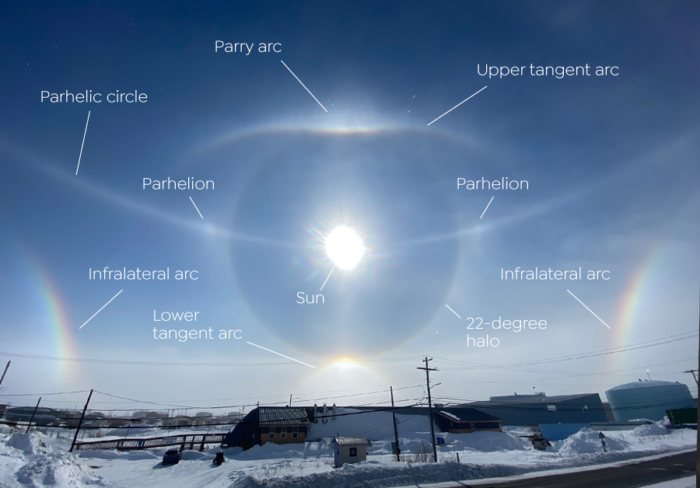Diamond Dust – A Treasure for Halo Spotters
High ice-crystal clouds like Cirrus and Cirrostratus can produce beautiful halos and arcs of light as the Sun shines through their tiny prism-like crystals. But high clouds are not the only ones to produce halo phenomena. A far lesser-known low cloud made of ice crystals can produce brighter and more vivid light effects. This sparkling mist of ice crystals, known as diamond dust, forms right down near the ground during bitterly cold and dry nights.
The glittering, halo-forming crystals develop through the night and into the morning when the sky above is clear, and the air still and cold – very cold. Temperatures below –20ºC (–4ºF) are best for diamond dust, making it a winter phenomenon most commonly found in polar regions. Don’t confuse it with regular ice fog, which forms as liquid fog droplets freeze in the air. The ice crystals in diamond dust develop as water vapour, the gas form of water, changes directly into ice – no middle-stage droplets are involved. This is a slow and steady process in dry conditions, producing tiny crystals with regular, simple geometric shapes like hexagonal columns or plates. Often, the crystals of diamond dust are so clear that they behave like tiny prisms, refracting and reflecting the sunlight as it shines through. This is when a whole range of beautiful arcs, rings and spots of light can appear in the glittering morning air, like they did for Robin Gage (Member 54,829) who spotted this collection of optical effects over Kotzebue, Alaska, US. Each light effect has a name, and some of the ones Robin spotted are quite rare.
The ring around the Sun is called a 22-degree halo and is formed by the light glinting through hexagonal-column crystals, like minuscule pencils of ice tumbling through the frigid morning air. Upper and lower tangent arcs appear touching the top and bottom of the 22-degree halo. The shape of these arcs differs with the elevation of the Sun, appearing like sharp ‘V’ shapes when it is low in the sky. The broad white line running through the Sun is known as a parhelic circle. Though it appears to curve upwards in the photo, this is just the distortion from Robin’s wide-angle lens. In reality, it is parallel to the horizon, sometimes extending in all directions to completely encircle the observer. It is the result of light reflecting off the sides of hexagonal-plate crystals falling horizontally, like autumn leaves. Slightly brighter spots appear on this line, just outside the 22-degree halo. Formed by the light shining through the hexagonal plates, these are called parhelia, or sun dogs. A common optical effect, these often appear independent of any of the other phenomena, to one or both sides of the Sun.
Much rarer are the brightly coloured infralateral arcs on the far left and far right. Like strange shards of rainbow, but in the wrong parts of the sky and with not a drop of rain in sight, these form as light glints through hexagonal columns aligned horizontally, by passing through an end and a side of the columns. Rarest of the lot, and almost too faint to notice, is a Parry arc curving downwards, just above the upper tangent arc. It’s rarity and faint appearance here are because the diamond-dust crystals need to be just right for this effect to appear: shaped as hexagonal columns that are aligned horizontally with their upper and lower sides facing directly upwards and downwards.
Clearly, with such specific requirements for the ice crystals, you have to be looking in the right place at the right time through the right sort of cloud to spot a dramatic halo display like Robin’s. For the intrepid cloudspotter willing to brave the cold, there is treasure to be found in diamond dust.
Halo phenomena spotted in diamond dust over Kotzebue, Alaska, US by Robin Gage (Member 54,829). View it in the photo gallery.





This is lovely – like a big eye in the sky!